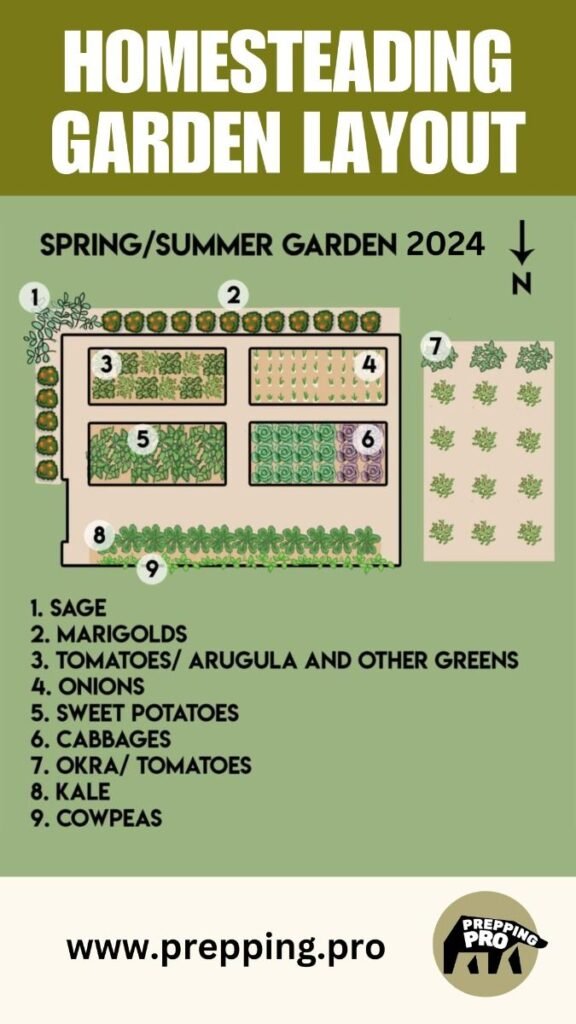As economic challenges continue to shape our world, many are turning to homesteading as a path towards greater self-sufficiency and resilience.
By embracing sustainable practices like permaculture design and organic gardening, homesteaders can create thriving ecosystems that provide for their needs while minimizing their environmental impact.
In this comprehensive guide, we’ll explore the crucial steps in designing an ideal one-acre homestead, optimized for both productivity and harmony with nature.
Table of Contents
Research and Planning

Before embarking on your homesteading journey, it’s essential to conduct thorough research and planning.
Explore resources on permaculture design, such as books by influential authors like Bill Mollison and David Holmgren, as well as online forums and local community groups.
Consult local agriculture extension offices for guidance on climate, soil conditions, and regulations specific to your area.
Additionally, consider attending workshops or taking courses on sustainable gardening and homesteading practices.
Steps to Designing an Ideal One-Acre Homestead

1. Zoning the Space
The first step in designing your homestead is to thoughtfully zone the available space.
Divide your one-acre plot into distinct areas based on their intended functions, such as gardening, livestock, orchards, and living quarters.
Permaculture design principles like zoning and sector analysis can help you optimize the placement of these areas for maximum efficiency and harmony with the natural environment.
2. Garden Design
Your garden will be the heart of your homestead, providing fresh produce for your family.
Consider implementing space-efficient methods like raised bed gardening and square foot gardening to maximize your yields.
Companion planting, a cornerstone of organic gardening, can help deter pests and promote plant health through symbiotic relationships between different crops.
Garden Planning Strategies:
- Utilize companion planting guides to determine ideal crop combinations.
- Incorporate heirloom seeds to preserve plant diversity and heritage.
- Implement a crop rotation schedule to maintain soil health and prevent disease.
- Plan for seasonal crop rotation to ensure a continuous supply of fresh produce.
Homestead Garden Layout

Raised Bed Gardening
Raised bed gardening is an excellent choice for maximizing space and improving soil quality in your homestead garden.
Raised beds can be constructed using various materials, such as wood, stone, or even repurposed materials like concrete blocks or tires.
By elevating the planting area, you can create a more controlled growing environment with better drainage and soil aeration.
Square Foot Gardening
Square foot gardening is a highly efficient method for maximizing yields in small spaces.
This approach divides the garden into square-foot sections, allowing you to plant a diverse array of crops in a compact area.
By carefully planning the layout and spacing of plants, you can minimize wasted space and optimize productivity.
Companion Planting
Companion planting is a cornerstone of organic gardening and an essential component of your homestead garden layout.
By strategically planting certain crops together, you can deter pests, improve soil health, and promote symbiotic relationships between plants.
For example, planting marigolds alongside tomatoes can help repel nematodes, while planting legumes like beans can fix nitrogen in the soil, benefiting nearby plants.
Pathways and Accessibility
When designing your homestead garden layout, consider incorporating efficient pathways that allow for easy access and maintenance.
Pathways should be wide enough to accommodate gardening tools and wheelbarrows, and ensure accessibility for all members of your household.
Strategically placed pathways can also help with water management and drainage.
| Crop Type | Companion Plants | Optimal Planting Season |
|---|---|---|
| Tomatoes | Basil, Marigolds | Spring to Early Summer |
| Cucumbers | Radishes, Sunflowers | Late Spring to Early Summer |
| Carrots | Rosemary, Chives | Early Spring to Late Summer |
3. Orchard and Vineyard
If space permits, consider incorporating an orchard and/or vineyard into your homestead design.
Permaculture design principles can guide the layout and management of these areas, ensuring they integrate seamlessly with the rest of your homestead.
Strategically select fruit and nut trees, as well as grapevines, that thrive in your local climate.
4. Livestock Area
Incorporating livestock into your homestead can provide a source of meat, eggs, and dairy products, as well as valuable manure for composting.
When designing your livestock area, consider how it can be integrated within a permaculture system to enhance the overall sustainability of your homestead.
5. Water Management
Efficient water management is crucial for a thriving homestead.
Explore permaculture water harvesting techniques like swales and keyline design to capture and store rainwater effectively.
Implement irrigation systems that minimize water waste, and consider incorporating greywater recycling systems for non-potable uses.
6. Composting Area
Organic gardening relies heavily on nutrient-rich compost to maintain soil health and fertility.
Designate an area for composting, where you can transform household and garden waste into valuable soil amendments.
Explore various composting methods, such as hot composting or vermicomposting (using worms), to find the approach that best suits your needs.
7. Rest and Recreation
While your homestead’s primary focus may be on production, don’t overlook the importance of creating spaces for rest and recreation.
Permaculture design emphasizes the integration of natural elements that contribute to overall well-being. Consider incorporating features like a peaceful seating area, a garden path, or a small pond to create a rejuvenating environment.
8. Energy Solutions
As part of your commitment to sustainability, explore renewable energy solutions that align with permaculture design principles.
Solar panels, wind turbines, or even a small hydroelectric system (if you have a water source) can help reduce your reliance on grid-based electricity and lower your carbon footprint.
9. Pathways and Accessibility
Efficient movement around your homestead is essential for minimizing energy expenditure and maximizing productivity.
Design pathways using permaculture principles, considering factors like slope, drainage, and proximity to key areas.
Ensure accessibility for all members of your household, including those with mobility challenges.
10. Seasonal Rotation
To maintain soil health and optimize garden productivity, implement a seasonal crop rotation plan. In square foot gardening and raised bed systems, rotate crops based on their nutrient requirements and growth habits.
This practice helps prevent soil depletion, reduces pest and disease pressure, and ensures a diverse and bountiful harvest throughout the growing season.
Conclusion

By integrating principles of homesteading, permaculture, and organic gardening, you can create a thriving one-acre homestead that provides for your needs while respecting the natural environment.
Through detailed planning and a willingness to think creatively about using limited space effectively, you can build a sustainable and resilient homestead that serves as a model for self-sufficiency and harmonious living.
Remember, designing your ideal homestead is an ongoing process of observation, adaptation, and continuous learning.
Embrace the journey, and don’t be afraid to experiment and make adjustments along the way.
With dedication and patience, your one-acre homestead will become a flourishing oasis of abundance and tranquility.


